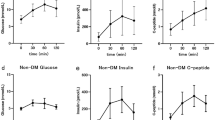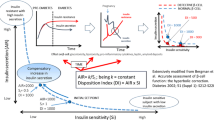Abstract
Purpose
The ileum-derived fibroblast growth factor 19 (FGF19) plays key roles in hepatic glucose homeostasis in animals in an insulin-independent manner. Here, we analyzed the association of FGF19 with glucose effectiveness (GE, the insulin-independent glucose regulation), as well as hepatic glucose production (HGP) in Chinese subjects.
Methods
GE was measured by frequently sampled intravenous glucose tolerance test (FSIVGTT) in normal glucose tolerance (NGT), isolated-impaired glucose tolerance (I-IGT), and isolated-impaired fasting glucose (I-IFG) subjects. The oral glucose tolerance test-derived surrogate of GE (oGE) was determined in NGT, I-IFG, combined glucose intolerance (CGI), and type 2 diabetes (T2DM) subjects. HGP was assessed by labeled ([3-3H]-glucose) hyperinsulinemic–euglycemic clamp in NGT subjects. Insulin secretion and sensitivity were calculated by the hyperglycemic and hyperinsulinemic-euglycemic clamps in a subgroup of NGT, I-IGT, and I-IFG subjects. Serum FGF19 levels were determined by ELISA.
Results
FGF19 positively correlated with GE (r = 0.29, P = 0.004) as determined by FSIVGTT. The result was further confirmed by oGE (r = 0.261, P < 0.001). FGF19 was negatively associated with FPG (r = − 0.228, P = 0.025), but the association no longer existed after adjusting for GE (r = − 0.177, P = 0.086). FGF19 was negatively associated with basal HGP (r = − 0.697, P = 0.006). However, the correlation between FGF19 and insulin secretion and sensitivity were not found.
Conclusions
FGF19 levels are associated positively with GE and negatively with HGP. The increase of FPG in human is at least partially due to the decrease of FGF19 in an insulin-independent manner.



Similar content being viewed by others
References
Best JD, Kahn SE, Ader M, Watanabe RM, Ni TC, Bergman RN (1996) Role of glucose effectiveness in the determination of glucose tolerance. Diabetes Care 19:1018–1030
Tonelli J, Kishore P, Lee DE, Hawkins M (2005) The regulation of glucose effectiveness: how glucose modulates its own production. Curr Opin Clin Nutr Metab Care 8:450–456
Lorenzo C, Wagenknecht LE, Rewers MJ, Karter AJ, Bergman RN, Hanley AJ, Haffner SM (2010) Disposition index, glucose effectiveness, and conversion to type 2 diabetes: the insulin resistance atherosclerosis study (IRAS). Diabetes Care 33:2098–2103
Lorenzo C, Wagenknecht LE, Karter AJ, Hanley AJ, Rewers MJ, Haffner SM (2011) Cross-sectional and longitudinal changes of glucose effectiveness in relation to glucose tolerance: the insulin resistance atherosclerosis study. Diabetes Care 34:1959–1964
Osei K, Rhinesmith S, Gaillard T, Schuster D (2004) Impaired insulin sensitivity, insulin secretion, and glucose effectiveness predict future development of impaired glucose tolerance and type 2 diabetes in pre-diabetic African Americans: implications for primary diabetes prevention. Diabetes Care 27:1439–1446
D’Alessio DA, Kahn SE, Leusner CR, Ensinck JW (1994) Glucagon-like peptide 1 enhances glucose tolerance both by stimulation of insulin release and by increasing insulin-independent glucose disposal. J Clin Investig 93:2263–2266
Itoh N, Ornitz DM (2004) Evolution of the Fgf and Fgfr gene families. Trends Genet 20:563–569
Itoh N (2010) Hormone-like (endocrine) Fgfs: their evolutionary history and roles in development, metabolism, and disease. Cell Tissue Res 342:1–11
Fukumoto S (2008) Actions and mode of actions of FGF19 subfamily members. Endocr J 55:23–31
Potthoff MJ, Kliewer SA, Mangelsdorf DJ (2012) Endocrine fibroblast growth factors 15/19 and 21: from feast to famine. Genes Dev 26:312–324
Kharitonenkov A, Shiyanova TL, Koester A, Ford AM, Micanovic R, Galbreath EJ, Sandusky GE, Hammond LJ, Moyers JS, Owens RA et al (2005) FGF-21 as a novel metabolic regulator. J Clin Investig 115:1627–1635
Jones S (2008) Mini-review: endocrine actions of fibroblast growth factor 19. Mol Pharm 5:42–48
Tomlinson E, Fu L, John L, Hultgren B, Huang X, Renz M, Stephan JP, Tsai SP, Powell-Braxton L, French D, Stewart TA (2002) Transgenic mice expressing human fibroblast growth factor-19 display increased metabolic rate and decreased adiposity. Endocrinology 143:1741–1747
Fu L, John LM, Adams SH, Yu XX, Tomlinson E, Renz M, Williams PM, Soriano R, Corpuz R, Moffat B et al (2004) Fibroblast growth factor 19 increases metabolic rate and reverses dietary and leptin-deficient diabetes. Endocrinology 145:2594–2603
Marcelin G, Jo YH, Li X, Schwartz GJ, Zhang Y, Dun NJ, Lyu RM, Blouet C, Chang JK, Chua S Jr (2014) Central action of FGF19 reduces hypothalamic AGRP/NPY neuron activity and improves glucose metabolism. Mol Metab 3:19–28
Kir S, Beddow SA, Samuel VT, Miller P, Previs SF, Suino-Powell K, Xu HE, Shulman GI, Kliewer SA, Mangelsdorf DJ (2011) FGF19 as a postprandial, insulin-independent activator of hepatic protein and glycogen synthesis. Science 331:1621–1624
Fang Q, Li H, Song Q, Yang W, Hou X, Ma X, Lu J, Xu A, Jia W (2013) Serum fibroblast growth factor 19 levels are decreased in Chinese subjects with impaired fasting glucose and inversely associated with fasting plasma glucose levels. Diabetes Care 36:2810–2814
Expert Committee on the Diagnosis and Classification of Diabetes Mellitus (2003) Report of the expert committee on the diagnosis and classification of diabetes mellitus. Diabetes Care 26(Suppl 1):S5–S20
Hanefeld M, Koehler C, Fuecker K, Henkel E, Schaper F, Temelkova-Kurktschiev T (2003) Insulin secretion and insulin sensitivity pattern is different in isolated impaired glucose tolerance and impaired fasting glucose: the risk factor in impaired glucose tolerance for atherosclerosis and diabetes study. Diabetes Care 26:868–874
Meyer C, Pimenta W, Woerle HJ, Van Haeften T, Szoke E, Mitrakou A, Gerich J (2006) Different mechanisms for impaired fasting glucose and impaired postprandial glucose tolerance in humans. Diabetes Care 29:1909–1914
Zhang J, Li H, Zhou H, Fang L, Xu J, Yan H, Chen S, Song Q, Zhang Y, Xu A et al (2017) Lowered fasting chenodeoxycholic acid correlated with the decrease of fibroblast growth factor 19 in Chinese subjects with impaired fasting glucose. Sci Rep 7:6042
Jia W, Chen L, Xiang K, Lu J, Bao Y, Xue F, Lu W (2001) Establishment of an extended hyperinsulinemic euglycemic clamp technique. Chin J Endocrinol Metab 17:268–271
Pacini G, Tonolo G, Sambataro M, Maioli M, Ciccarese M, Brocco E, Avogaro A, Nosadini R (1998) Insulin sensitivity and glucose effectiveness: minimal model analysis of regular and insulin-modified FSIGT. Am J Physiol 274:E592–E599
Steil GM, Volund A, Kahn SE, Bergman RN (1993) Reduced sample number for calculation of insulin sensitivity and glucose effectiveness from the minimal model. Suitability for use in population studies. Diabetes 42:250–256
Morbiducci U, Di Benedetto G, Kautzky-Willer A, Pacini G, Tura A (2007) Improved usability of the minimal model of insulin sensitivity based on an automated approach and genetic algorithms for parameter estimation. Clin Sci (Lond) 112:257–263
Morton GJ, Matsen ME, Bracy DP, Meek TH, Nguyen HT, Stefanovski D, Bergman RN, Wasserman DH, Schwartz MW (2013) FGF19 action in the brain induces insulin-independent glucose lowering. J Clin Invest 123:4799–4808
Nagasaka S, Kusaka I, Yamashita K, Funase Y, Yamauchi K, Katakura M, Ishibashi S, Aizawa T (2012) Index of glucose effectiveness derived from oral glucose tolerance test. Acta Diabetol 49(Suppl 1):S195–S204
Jia W, Wu H, Bao Y, Wang C, Lu J, Zhu J, Xiang K (2007) Association of serum retinol-binding protein 4 and visceral adiposity in Chinese subjects with and without type 2 diabetes. J Clin Endocrinol Metab 92:3224–3229
Li H, Bao Y, Xu A, Pan X, Lu J, Wu H, Lu H, Xiang K, Jia W (2009) Serum fibroblast growth factor 21 is associated with adverse lipid profiles and gamma-glutamyltransferase but not insulin sensitivity in Chinese subjects. J Clin Endocrinol Metab 94:2151–2156
DeFronzo RA, Tobin JD, Andres R (1979) Glucose clamp technique: a method for quantifying insulin secretion and resistance. Am J Physiol 237:E214–E223
DeFronzo RA, Gunnarsson R, Bjorkman O, Olsson M, Wahren J (1985) Effects of insulin on peripheral and splanchnic glucose metabolism in noninsulin-dependent (type II) diabetes mellitus. J Clin Investig 76:149–155
Matsuda M, DeFronzo RA (1999) Insulin sensitivity indices obtained from oral glucose tolerance testing: comparison with the euglycemic insulin clamp. Diabetes Care 22:1462–1470
Matthews DR, Hosker JP, Rudenski AS, Naylor BA, Treacher DF, Turner RC (1985) Homeostasis model assessment: insulin resistance and beta-cell function from fasting plasma glucose and insulin concentrations in man. Diabetologia 28:412–419
Potthoff MJ, Boney-Montoya J, Choi M, He T, Sunny NE, Satapati S, Suino-Powell K, Xu HE, Gerard RD, Finck BN et al (2011) FGF15/19 regulates hepatic glucose metabolism by inhibiting the CREB-PGC-1alpha pathway. Cell Metab 13:729–738
Egede MB, Henriksen JE, Durck TT, Levin K, Rantzau C, Ward G, Beck-Nielsen H, Alford FP (2014) Glucose effectiveness in nondiabetic relatives: dysglycemia and beta-cell function at 10 years. J Clin Endocrinol Metab 99:1420–1424
Bergman RN (1989) Lilly lecture 1989. Toward physiological understanding of glucose tolerance. Minimal-model approach. Diabetes 1989(38):1512–1527
Ryan KK, Kohli R, Gutierrez-Aguilar R, Gaitonde SG, Woods SC, Seeley RJ (2013) Fibroblast growth factor-19 action in the brain reduces food intake and body weight and improves glucose tolerance in male rats. Endocrinology 154:9–15
Kurosu H, Choi M, Ogawa Y, Dickson AS, Goetz R, Eliseenkova AV, Mohammadi M, Rosenblatt KP, Kliewer SA, Kuro-o M (2007) Tissue-specific expression of betaKlotho and fibroblast growth factor (FGF) receptor isoforms determines metabolic activity of FGF19 and FGF21. J Biol Chem 282:26687–26695
Lin BC, Wang M, Blackmore C, Desnoyers LR (2007) Liver-specific activities of FGF19 require Klotho beta. J Biol Chem 282:27277–27284
DeFronzo RA, Bonadonna RC, Ferrannini E (1992) Pathogenesis of NIDDM. A balanced overview. Diabetes Care 15:318–368
Ader M, Ni TC, Bergman RN (1997) Glucose effectiveness assessed under dynamic and steady state conditions Comparability of uptake versus production components. J Clin Investig 99:1187–1199
Acknowledgements
The authors would like to thank Junxi Lu, Wei Zhu, Yiting Shen, and Jia Wang (Shanghai Jiao Tong University Affiliated Sixth People’s Hospital) for excellent technical assistance. The authors gratefully acknowledge all of the involved clinicians, nurses, and technicians at Shanghai Jiao Tong University Affiliated Sixth People’s Hospital for their dedication in this study. The authors would also like to thank all the colleagues in the Metabolic Disease Biobank Resource at Shanghai Jiao Tong University Affiliated Sixth People’s Hospital for the technical support.
Funding
This work was supported by the National Natural Science Foundation major international (regional) joint research project (81220108006) to W.J., the Shanghai Natural Science Foundation (15ZR1431700) and Major Program of Shanghai Municipality for Basic Research (10JC1412400) to Q.F., and Young Scientists Fund of National Natural Science Foundation of China (81200292) to H.L.
Author information
Authors and Affiliations
Contributions
JZ designed the research, conducted the experiments, analyzed data, and wrote the manuscript. HL contributed to the study design and manuscript writing. NB, YX, QS, LZ, GW, SC, XH, CW, and LW performed research. AX was involved in revising the manuscript. QF designed the study, interpreted data, and revised the manuscript. WJ designed the study, revised the manuscript, and contributed to the discussion. All authors have made substantial contributions and approved the final version of the manuscript.
Corresponding authors
Ethics declarations
Conflict of interest
The authors declare that they have no conflict of interest.
Research involving human participants
All procedures performed in studies involving human participants were in accordance with the ethical standards of the institutional and/or national research committee and with the 1964 Helsinki declaration and its later amendments or comparable ethical standards.
Informed consent
Informed consent was obtained from all individual participants included in the study.
Additional information
Publisher's Note
Springer Nature remains neutral with regard to jurisdictional claims in published maps and institutional affiliations.
Electronic supplementary material
Below is the link to the electronic supplementary material.
Rights and permissions
About this article
Cite this article
Zhang, J., Li, H., Bai, N. et al. Decrease of FGF19 contributes to the increase of fasting glucose in human in an insulin-independent manner. J Endocrinol Invest 42, 1019–1027 (2019). https://doi.org/10.1007/s40618-019-01018-5
Received:
Accepted:
Published:
Issue Date:
DOI: https://doi.org/10.1007/s40618-019-01018-5




